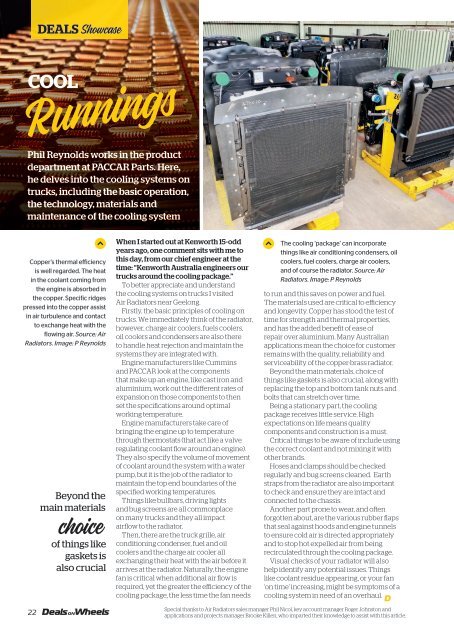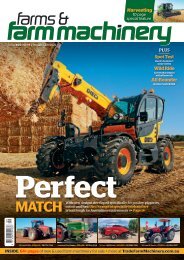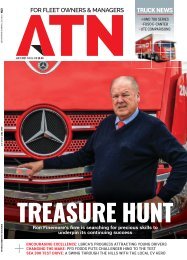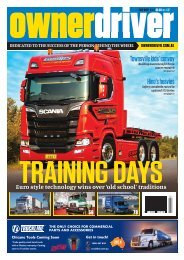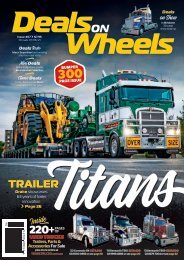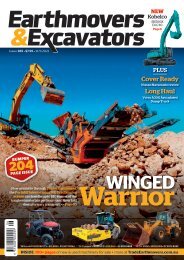Deals on Wheels #469
You also want an ePaper? Increase the reach of your titles
YUMPU automatically turns print PDFs into web optimized ePapers that Google loves.
DEALS Showcase<br />
COOL<br />
Runnings<br />
Phil Reynolds works in the product<br />
department at PACCAR Parts. Here,<br />
he delves into the cooling systems <strong>on</strong><br />
trucks, including the basic operati<strong>on</strong>,<br />
the technology, materials and<br />
maintenance of the cooling system<br />
Copper’s thermal efficiency<br />
is well regarded. The heat<br />
in the coolant coming from<br />
the engine is absorbed in<br />
the copper. Specific ridges<br />
pressed into the copper assist<br />
in air turbulence and c<strong>on</strong>tact<br />
to exchange heat with the<br />
flowing air. Source: Air<br />
Radiators. Image: P Reynolds<br />
Bey<strong>on</strong>d the<br />
main materials<br />
choice<br />
of things like<br />
gaskets is<br />
also crucial<br />
When I started out at Kenworth 15-odd<br />
years ago, <strong>on</strong>e comment sits with me to<br />
this day, from our chief engineer at the<br />
time: “Kenworth Australia engineers our<br />
trucks around the cooling package.”<br />
To better appreciate and understand<br />
the cooling systems <strong>on</strong> trucks I visited<br />
Air Radiators near Geel<strong>on</strong>g.<br />
Firstly, the basic principles of cooling <strong>on</strong><br />
trucks. We immediately think of the radiator,<br />
however, charge air coolers, fuels coolers,<br />
oil coolers and c<strong>on</strong>densers are also there<br />
to handle heat rejecti<strong>on</strong> and maintain the<br />
systems they are integrated with.<br />
Engine manufacturers like Cummins<br />
and PACCAR look at the comp<strong>on</strong>ents<br />
that make up an engine, like cast ir<strong>on</strong> and<br />
aluminium, work out the different rates of<br />
expansi<strong>on</strong> <strong>on</strong> those comp<strong>on</strong>ents to then<br />
set the specificati<strong>on</strong>s around optimal<br />
working temperature.<br />
Engine manufacturers take care of<br />
bringing the engine up to temperature<br />
through thermostats (that act like a valve<br />
regulating coolant flow around an engine).<br />
They also specify the volume of movement<br />
of coolant around the system with a water<br />
pump, but it is the job of the radiator to<br />
maintain the top end boundaries of the<br />
specified working temperatures.<br />
Things like bullbars, driving lights<br />
and bug screens are all comm<strong>on</strong>place<br />
<strong>on</strong> many trucks and they all impact<br />
airflow to the radiator.<br />
Then, there are the truck grille, air<br />
c<strong>on</strong>diti<strong>on</strong>ing c<strong>on</strong>denser, fuel and oil<br />
coolers and the charge air cooler all<br />
exchanging their heat with the air before it<br />
arrives at the radiator. Naturally, the engine<br />
fan is critical when additi<strong>on</strong>al air flow is<br />
required, yet the greater the efficiency of the<br />
cooling package, the less time the fan needs<br />
The cooling ‘package’ can incorporate<br />
things like air c<strong>on</strong>diti<strong>on</strong>ing c<strong>on</strong>densers, oil<br />
coolers, fuel coolers, charge air coolers,<br />
and of course the radiator. Source: Air<br />
Radiators. Image: P Reynolds<br />
to run and this saves <strong>on</strong> power and fuel.<br />
The materials used are critical to efficiency<br />
and l<strong>on</strong>gevity. Copper has stood the test of<br />
time for strength and thermal properties,<br />
and has the added benefit of ease of<br />
repair over aluminium. Many Australian<br />
applicati<strong>on</strong>s mean the choice for customer<br />
remains with the quality, reliability and<br />
serviceability of the copper-brass radiator.<br />
Bey<strong>on</strong>d the main materials, choice of<br />
things like gaskets is also crucial, al<strong>on</strong>g with<br />
replacing the top and bottom tank nuts and<br />
bolts that can stretch over time.<br />
Being a stati<strong>on</strong>ary part, the cooling<br />
package receives little service. High<br />
expectati<strong>on</strong>s <strong>on</strong> life means quality<br />
comp<strong>on</strong>ents and c<strong>on</strong>structi<strong>on</strong> is a must.<br />
Critical things to be aware of include using<br />
the correct coolant and not mixing it with<br />
other brands.<br />
Hoses and clamps should be checked<br />
regularly and bug screens cleaned. Earth<br />
straps from the radiator are also important<br />
to check and ensure they are intact and<br />
c<strong>on</strong>nected to the chassis.<br />
Another part pr<strong>on</strong>e to wear, and often<br />
forgotten about, are the various rubber flaps<br />
that seal against hoods and engine tunnels<br />
to ensure cold air is directed appropriately<br />
and to stop hot expelled air from being<br />
recirculated through the cooling package.<br />
Visual checks of your radiator will also<br />
help identify any potential issues. Things<br />
like coolant residue appearing, or your fan<br />
‘<strong>on</strong> time’ increasing, might be symptoms of a<br />
cooling system in need of an overhaul.<br />
22<br />
Special thanks to Air Radiators sales manager Phil Nicol, key account manager Roger Johnst<strong>on</strong> and<br />
applicati<strong>on</strong>s and projects manager Brooke Killen, who imparted their knowledge to assist with this article.


